TAHOME - SPRING MIGRATION
About Migration
Many animals move over great distances from one place to another in search of resources, such as food, space to raise their babies, mates, or better weather.
Although some animals are able to find food despite the harsh snowy conditions, many animals can’t find enough food during Tahoe winters, forcing them to travel elsewhere. In spring, the snow melts, plants grow, and more food becomes available, inviting animals from all over North and South America to spend their time here in Tahoe, and sometimes breed in the warmer months.
In springtime, Tahoe sees animals arriving, leaving, and passing through. Bald Eagles and several duck species may travel north to Alaska and Canada from Tahoe at this time. Other animals, like American Robins, Tree Swallows, and Mule Deer migrate back into the area in the spring.
A third group, including Snow Geese, Sandhill Cranes, and Painted Lady butterflies, may be seen migrating through the Tahoe area at this time. Other animals may only use Tahoe as a rest stop on their journey to somewhere else. For example, Arctic Terns are birds that travel from the North Pole to the South Pole each year and have been spotted in Tahoe along the way.
Scientists can predict when animals will migrate because these travel patterns typically occur around the same time, such as with changing seasons. While most animals migrate seasonally, some, including fish or zooplankton that live in Lake Tahoe or in the ocean, migrate up and down through the water column daily.
Navigation Through Migration
Migrating animals navigate in a few different ways. Some sense magnetic fields that surround the earth, much like a compass.
A second way animals navigate during migration is using features in the sky. Birds can figure out where they are in the world based on where the sun is in the sky. Many animals use the night sky to navigate. Some animals look for a bright star like the North Star, while others look for star patterns or track the moon. Other animals may simply follow landscape features, such as mountain ranges or rivers, often along pathways learned from older animals.
Search areas near water or look overhead for these birds flying in formation.
Look for this common bird to increase in numbers in the trees or on the ground near your home.
Watch and listen for large groups of these tall birds flying overhead in the evenings.
Activities for K-2 Grade Students:
Know Where to Go
Knowing where to go is the first step in migration. Learn more about where you are in your home using a compass.
Find a compass. If someone in your house has a smart phone they likely already have a compass on their phone, or can download a free compass app.
Face your front door from the inside of your house. Point your compass toward your door to figure out which direction it faces.
Write down the direction your door faces.







